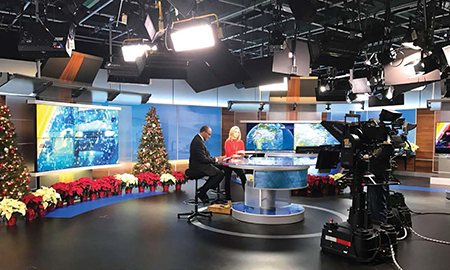At WBAL-TV, It’s HD v2.0
BALTIMORE—For Jeff Halapin and Kerry Plackmeyer, the news about getting an upgrade at WBAL’s eight-year-old HD studio was akin to getting a great Christmas present—a gift that was up and operating before the first Christmas trees appeared in Baltimore department stores.

Stan Stovall, left, and Donna Hamilton take a break on WBAL-TV’s recently refreshed HD set during the evening edition of 11 News. So it was a great day when Halapin, director of engineering, and Plackmeyer, the station’s assistant director of engineering, were informed by station manager Dan Joerres that WBAL, as well as WTAE, in Pittsburgh, would be the first stations in line in the 30-station Hearst chain to get an HD set refresh.
While WBAL built its original HD set in late 2008 (“WBAL Joins the HD News Ranks,” Feb. 18, 2009), with this go ’round the requirements shifted, as only parts of the technical operation needed to be replaced.
A local college was given the old equipment in exchange for moving it out of the studio—which took three days to complete. It took another eight days for Halapin, Plackmeyer and company to complete the infrastructure and video prep work to get the 66-foot by 44-foot studio ready for the update.
The result? A project that has “raised the bar for HD sets, not just for Hearst, but within the industry,” said Halapin, noting that upgrades could take place at other Hearst stations in 2017.
PREP WORK
Back at WBAL, it was first things first, as the previous equipment was removed and moved to nearby Morgan State University, which is also based in the city. Next, Halapin, Plackmeyer and company got the studio ready for the new install, which included the removal of many remnants, some of which had been in the studio for decades.
“First, we removed legacy cabling, junction boxes, old pulleys and anything else that wasn’t active,” said Plackmeyer. “Then we cleaned the grid, tore down the ram-board and painted the floors.”
The professional video industry's #1 source for news, trends and product and tech information. Sign up below.
The next step was removal of the incandescent lighting, in favor of the LED florescent DeSisti and Lupo technology, which raised the color temperatures from 3,200 to 5,000 kelvins; in addition, a large portion of the set now features lightboxes around its perimeter that allow for the changing of the colors (orange for the Baltimore Orioles during baseball season, purple for the Baltimore Ravens after the NFL kicks off, etc.). They are controlled from the grid with DMX technology.
The set also has new desk lights that match the florescence of the walls, and “are similar to what’s used on ‘The Today Show,’” Halapin said.

The refresh at WBAL-TV, Baltimore, has “raised the bar for HD sets, not just for Hearst, but within the industry,” said the station’s director of engineering, Jeff Halapin. Pictured are long-time market anchors Stan Stovall and Donna Hamilton.THE DESIGN AND BUILD
Another difference during the recent install, as opposed to the first one, was that WBAL acted as its own system integrator, instead of subbing that part of the job out as it had in 2008. “That’s because of we have a highly competent technical team,” said Halapin.
Devlin Design Group of Crested Butte, Colo., contracted for the design/build. Key additions to the set included two monitor walls from Primeview—a 1x6 and a 2x2 each of which consist of six and four panels, respectively, that run with extreme 3.5mm bezels, and are driven by a Vizrt graphics engines.
“When we moved back into the finished product, all we had to do was move cables and the KVM transceivers,” Plackmeyer said.
But, as noted, not everything was updated during the refresh. For instance, the station’s three Sony HCG 1400 cameras remain, as do their Vinten FP 188 pedestals (which were installed in 2011); and the contents of the control room, which features a 70-inch Barco cube monitor wall, Sony 8000G switcher and a Wheatstone D-10 audio board, are still intact.
“We keep the graphics equipment the same at every Hearst station because we want that standardization,” Halapin said.
During construction, news programming was presented from a few points under roof, mainly originating inside the newsroom and from a temporary green screen area that is usually used for commercial production that lies adjacent to the project area. There were various temporary connectivity points around the station, as well.
“We started from scratch last time. Everything was new,” Halapin said. “This time, while it still took us 300 hours in planning, it was just the set. Everything was drawn out in advance, even the temporary stuff.”
A DONE DEAL
Halapin remarked that, while the refresh marked a major event in the station’s technical history, it wasn’t as momentous and the 2008 project. “This was a much easier transition,” he said, “especially because the station was able to acquire the necessary funding from corporate on the first swing.”
While Plackmeyer’s perspective was a little different since he was working for WBAL Radio in late 2008, the refresh marked a major point in his career, too. “I love big projects,” he said, recalling the 12–16 hour days that he and the rest of the crew put in during the busiest days of the refresh.
“I’m real OCD and I want everything right,” he said, “but despite the size of the job, I’d be glad to do it again.”
Mark R. Smith has covered the media industry for a variety of industry publications, with his articles for TV Technology often focusing on sports. He’s written numerous stories about all of the major U.S. sports leagues.
Based in the Baltimore-Washington area, the byline of Smith, who has also served as the long-time editor-in-chief for The Business Monthly, Columbia, Md., initially appeared in TV Technology and in another Futurenet publication, Mix, in the late ’90s. His work has also appeared in numerous other publications.

